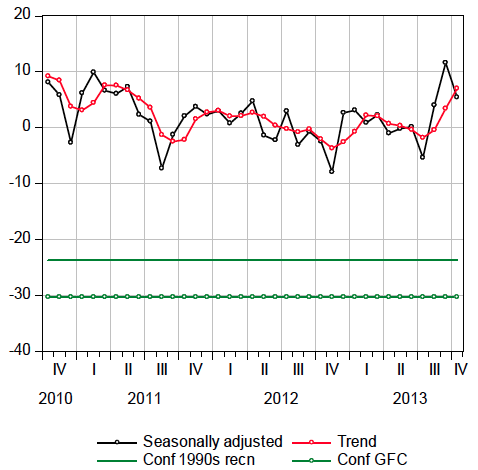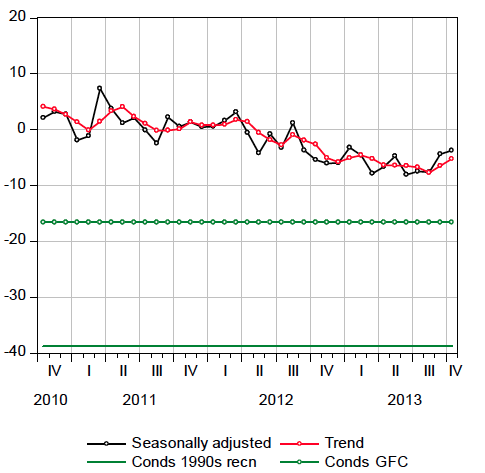That flighty, post-Federal election boost to business confidence has gone, evaporating over the past month as realism about the economy overtook the optimism.
And not even the record low interest rates and a rebounding housing sector has managed to stop the fall, or improve the way businesses view conditions in the economy.
The fall in confidence, and continuing weak conditions were outlined in the monthly survey of business from the National Australia Bank, released yesterday.
The news helped puncture a 30 point early rise in the stockmarket. The ASX 200 ended the day up just six points.
Business confidence declined to +5 points from +12 points in September, according to the survey, while business conditions stayed at a weak – minus 4 points.
"Businesses may have reassessed their expectations about future activity given continued weakness in actual business conditions," NAB’s chief economist Alan Oster said in an accompanying statement.
"Nonetheless, overall confidence remains relatively higher than the well below-average levels over the previous three years."
While that might be the case, economic growth and the outlook for the economy is probably weaker than three years ago as the mining investment boom slows and unemployment rises.
Firms surveyed by the NAB were less positive in October after that post poll surge of sentiment in September.

Business confidence falls on the back of weak conditions. Source:NAB
And the NAB said soft forward indicators in the survey pointed to a weak outlook for domestic demand.
"Forward indicators do not paint a favourable picture for the outlook, with capacity utilisation falling to a four-year low and the level of forward orders, capex and stocks also declining," Mr Oster said in yesterday’s statement.
"While employment conditions lifted to a one-year high, the index remained negative implying further jobs shedding."
And that was confirmed by the October jobs report which was weak with lots of part time jobs created by more than 27,000 full time jobs going in the month. The participation rate eased, again telling us that more people have stopped looking for work.
The fall in confidence and continuing sluggish business conditions confirms the gloomy economic outlook the Reserve Bank revealed last week in its 4th and final Statement of Monetary Policy for the year.
The RBA said last week it was too soon to judge how "persistent" recent improvements in household and business sentiment would prove to be following a year-long slowdown.
It forecast a continuing, slow rise in unemployment and trimmed next year’s economic growth forecast, anticipating a steeper-than-expected decline in mining investment as the resources boom fades.
Growth in 2014 will now be between 2% to 3% instead of 2.75% to 3.25%, as in earlier forecasts this year.
The survey said forward orders fell by two points to minus 2 last month, while capacity utilisation sank 0.9 percentage points to 79.3% – its lowest level since June 2009 as the economy was recovery from the hit from the GFC at the end of 2008 (and around the time of the previous peak in unemployment).
Capital expenditure slipped by 5 points to minus 2, as labour costs growth eased by 0.5%.
Employment and trading conditions strengthened for the month, but were weighed down by profitability, which wound back some of its September gains to fall from minus 4 to minus 6.

Business conditions remain lackluster. Source:NAB
Although at minus 4, conditions were still weak, but that was a stronger reading than the minus 8 in August.
And that was reflected in a couple of glimmers of light with a small improvement in conditions in the mining sector on the back of rising commodity prices.
There were also small lifts in the transport and utilities and retail and manufacturing industries. (Was that reflected in the stronger 0.8% jump in seasonally adjusted retail sales in September and the improvement in manufacturing activity in the monthly survey of manufacturing activity which has moved back into the expansion phase for the first time in more than two years?)
"Conditions in wholesale also improved – an industry that tends to be a bellwether of future demand – which may indicate some improvement in future conditions," Mr Oster added.
NAB said the survey pointed to underlying demand growth of about 2.75% in the third-quarter, and GDP growth of about 2.5%.













